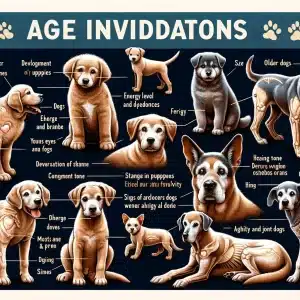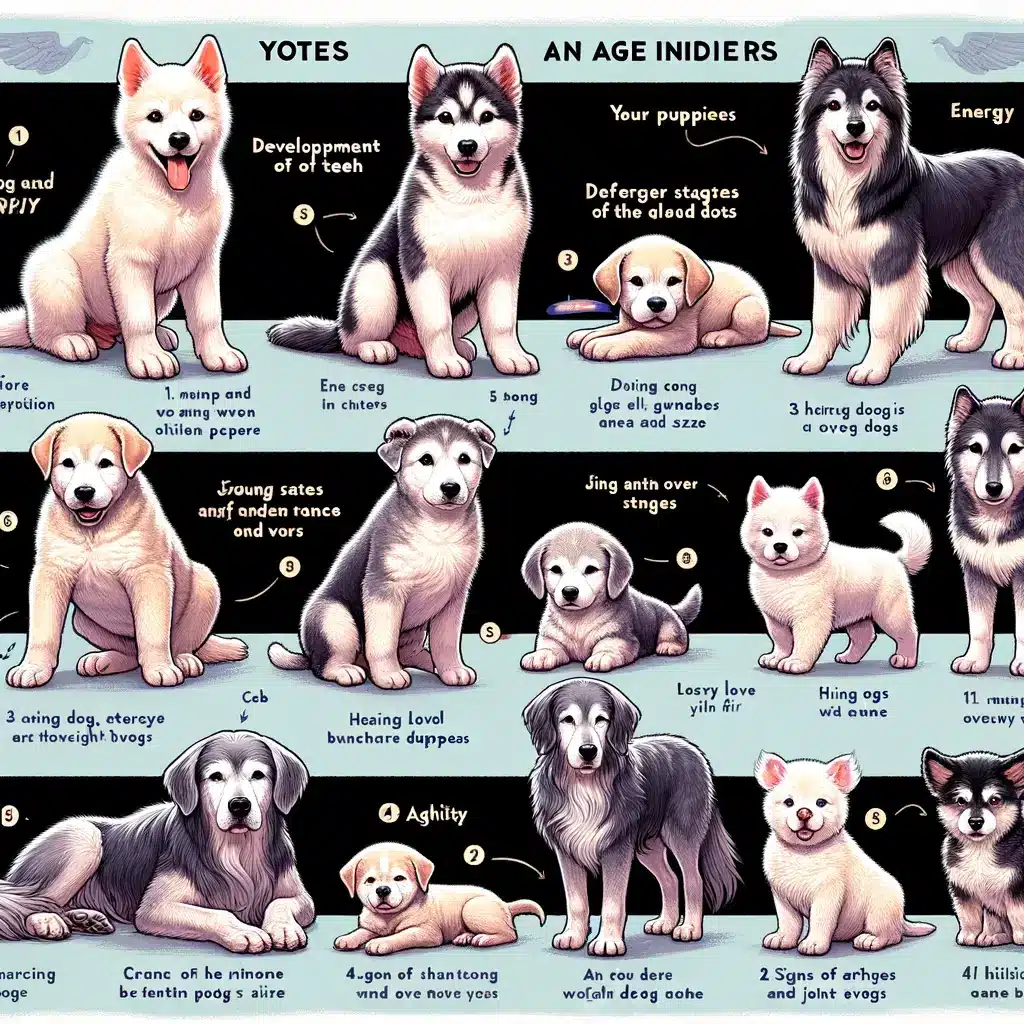How to Tell the Age of a Dog?- Many of you do love to have dogs as pets. Some of you like to have them when they are small puppies only, while many of you prefer to have adult dogs.
Sometimes, even though you are adopting the puppy, you are still unsure about their age. Often, the medical histories and genetic records are not correctly acquired. That’s why you need to know how to tell a dog’s age.
To estimate the age of a dog, consider the following indicators:
- Teeth: Puppy teeth are replaced by permanent teeth around 4-6 months.
- Teeth wear: As dogs age, teeth may show wear, tartar buildup, or discoloration.
- Eyes: Puppies have bright and clear eyes, while older dogs may develop cloudiness.
- Coat: Puppies usually have soft and fluffy fur that changes with age.
- Muscles and weight: Younger dogs have firmer muscles, while older dogs may lose muscle tone.
- Behavior and energy levels: Puppies are typically more energetic than adult or senior dogs.
Sometimes, it becomes difficult for you to have a specific clue on what is the actual age of your pup.
So here today, we will help you consider some of the critical parameters that will help determine the dog’s age at once. Stay tuned and follow the pointers in the low-down section.

How to Tell the Age of a Dog?
Now we will discuss some of the possible signs that tell how to decide what is the age of the dog.
Teeth of a Puppy
If you have a small puppy, you can quickly identify its age by examining the teeth. Remember that teeth will start to develop from the initial years of the puppy. The phases of the teeth development of a puppy tell what’s their average age.
You will see that teeth will start to penetrate through the gums of one-month-old puppies. At the same time, a two-month-old puppy will have a complete set of baby teeth in the front of the mouth. On the other hand, the four-month puppies will have incisors and canines.
Just as your puppy reaches seven months, it will have molars and a fully adult teeth set. As the puppy touches one year, the ridges begin to appear on both upper and lower frontal teeth.
Change in Teeth in Aged Dogs
With age, the teeth in dogs tend to change. This change is the best parameter that lets you evaluate the dog’s age. As the age commences, the ridges on the incisors begin to change.
As the dog reaches three years, the ridges will get sharper on the upper part of the incisors. Remember that small shaped ridges on the four frontal teeth will start to show up as they reach four years. By the age of seven years, the dogs will have a complete pack of smooth teeth.
Energy Level
One more sign that you can always look for is your dog’s energy level. As your dog gets older, he tends to be less energetic compared to the older dogs.
Also, dogs with age will have benign blocks of flesh on their body. The younger dogs will have more muscles than the older dogs. Also, old ones won’t get much interested in playing.
Eyes of the Dog
The eyes of the dog will also tell what the age of your dog is. Remember, as the dog begins to get older, it will have foggy eyes, which causes the dog’s lens to get hardened. This process is known as lenticular sclerosis.
With these other possible signs, such as showing less energy and smooth teeth, you can stay assured that your pup is seven years now.
Besides that, you also need to check whether your dog has a white-colored opaque-shaped patch on the eyes or not.
If yes, your dog is getting older as these signs are majorly seen in older dogs. Note that the reason behind cataracts can be because of genetic disorders. And it impacts the sight of the dog, whereas lenticular sclerosis doesn’t.
Colour of the Fur
Week-old puppies will have glossy, shiny fur, but as the dogs start to age, the color of the fur will change. Even it will also begin to lose its sheen as well. As the dogs cross five years of age, the fur will start to get gray.
This gray hair is generally seen in and around the muzzle area. But one thing you also need to remember is that some dogs show gray hair, and that can be due to genetic reasons.
Breed and Size of the Dog
Larger breed dogs tend to have a short life duration. Also, the larger breeds tend to show signs of aging when small compared to the small breed dogs.
Remember that larger dogs begin to age early. To be precise, large breed dogs start to age at around 7 to 8 years, while smaller dogs start to an age when they reach ten years of age or beyond that.
The Power of Hearing
Aside from eyesight, the power of hearing also determines your dog’s age precisely. Dogs always hear sound and sharp at a younger age compared to the dogs who have aged a bit.
An older dog will not only have a problem hearing you but also will respond to you late, especially when you call your dog for snacks or during mealtime.
Indeed, you can take the help of your vet in that case and do as they advise you to do, especially when the issue is of hearing loss.
Muscles of the Dog
The tone and shape of the muscle also tell what is the age of your dog approximately. In addition, the body shape helps to determine the same as well.
When you look at puppies, you will see they have fluffy, well coated, rounded bodies with less toned muscle. Also, the ears and paws look oversize.
Now middle-aged dogs with sound health will have defined, sleek bodies with more toned muscles. But dogs who have aged will have a less toned muscle and will look bony. On top of that, the aged dogs will have more weight.
Arthritis or pain in the joints
Dogs do suffer from joint disorders like dysplasia on the hip and arthritis. Now, if the puppy begins to walk with discomfort or may limp, you may not be aware of the cause.
On the other hand, if your dog is older, it might get arthritis. You can always take the dog to the vet to reduce the pain.
Agility and Activity
It is pretty easy to understand that younger dogs are more agile and are always at ease when it comes to mobility. As the dog ages, they tend to lose energy and somehow finds it difficult to climb up the stairs and go down smoothly. Also, it turns out tougher for them to run, jump, or hop.
Aged dogs don’t show much interest in catching up with activities. Like you will find them preferring an afternoon nap rather than running after a ball. So you should intensely monitor how active your dog is when it comes to doing various physical work.
Also, supervise their body posture and way of walking to check whether any stiffness or joint issue is there or not.
Genetics of the Dog
Well, the above-described methods will always tell how old your dog is. But you can never deny that genetics play a dual role along with these.
Based on the data obtained regarding the medical record, activity, diet level, and breed, you will always come to know whether your dog is aging or not.
These determinants will also show whether they stay aloof or takes an active part in various activities.
Weight of the Dog
Besides all these, you should know that dogs also suffer from varied weight, which differs with age, like human beings.
It is seen that dogs tend to deposit fat beneath the back portion. This sign is helpful, especially when people like to adopt rescued dogs. Indeed, it also helps you tell whether the dog is healthy or not.
Some Other Clues Related to Teeth Age of a Dog
Apart from the above-discussed portion, you can also tell a dog’s age by examining more factors related to the teeth.
- For eight weeks of a puppy, all the baby teeth will be there
- For a 7-month-old puppy, the teeth will be permanent and white.
- For dogs aging between 1 to 2 years, the teeth will look dull, and the back part of the teeth will start to get yellow.
- For 3 to 5 years old dogs, the Tartar will develop around the teeth area.
- As the dog reaches 5 to 10 years, the teeth will wear and tear. In addition to that, some possible signs of disease can be seen as well.
- Finally, as the dog reaches 10 to 15 years, the Tartar will get heavier, teeth will look worn out, and even some may get missing as well.
Thus, these are some of the critical ways that will help you how to tell the age of a dog. Hope you can now quickly say the age of a dog without asking the owner, buying or rescuing shelters, and now no one can trick you as well.
Your dog is an adorable one, no matter what the age is. But at times, you may decide to adopt a rescued dog or want to have a small puppy; in that case, the mentioned signs in the content will help you understand the age.








